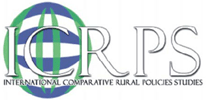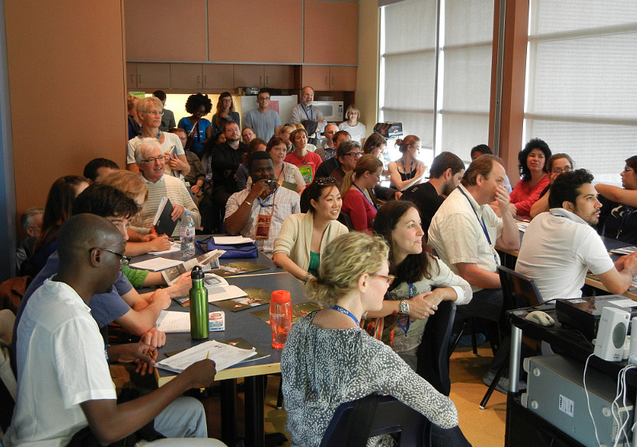by John Bryden and Karen Refsgaard, 30/06/2012
We have much enjoyed our 8 days with Faculty and Students at the 2012 Summer Institute organised by our colleagues at Concordia University and UQAR (University of Quebec at Rimousky). We have some reflections on Quebec Rural Policy to offer as a result of the discussions and inputs so far.
Quebec turns its face to Europe, and its back to Ottawa (Canadian Federal Government) when it comes to ‘rural policy’. Thus rural policy here looks like LEADER in Europe, a fact which is not at all surprising when one considers the coming and going of LEADER action groups and the Leader Observatory (in which John was involved) in the formative period of the policy. It is aimed mainly at community mobilisation at the MRC administrative level[1], and its total budget is very small, comparable with LEADER which has been around 1% of the budget for the common agricultural policy at EU level. It is what the Finnish Government and Rural Policy Committee term ‘narrow rural policy’, an extra policy layer on top of all the sectoral policies which spend most public money and together have by far the largest economic, social and environmental impacts on rural regions[2]. ‘Broad’ rural policy considers all important public sector policies impacting on rural, and argues that it is not sufficient to consider only ‘narrow’ rural policy.
Thus both LEADER and Quebec rural policy fail to consider the other important policies with significant rural impacts, which are managed in another way. These include Natural Resources and Minerals, Agriculture, Forestry, Fisheries, Social Welfare, Education, Health, Housing, Land ownership and tenure, Land Use (Planning), Energy (and Renewable Energy), Environment, Local Government, Transport, Infrastructure, Regional Development and Innovation, Immigration, and in Canada, Northern Affairs etc (especially the Inuit and Native American issues). In fact, as in many but not all other countries, these policy issues (control over decisions and budgets) are very centralised at the Provincial or Federal levels in Canada, and Quebec, even if it does have a stronger structure of local government than other Provinces, is no exception. In most countries, such policies account for perhaps 90% of public expenditure in rural regions and even if public spending is small the decisions taken and regulations around them are normally crucial for the sustainability of rural communities. Indeed they can motivate and determine the extent and nature of rural disadvantage and rural-urban migration. The extent of centralisation is also reflected in the weakness of local budgets and taxation powers, since nearly all taxes are paid to Provincial level and then reallocated via central and sectoral budgeting and spending processes.
It is understandable in this context that there is a focus on community empowerment, since communities (whether rural or urban) are deeply disempowered by the centralisation of decision making and public budgets. However, although it is necessary and good to encourage and enable an active citizenry, this is not sufficient to empower communities! They must also have sufficient control over decisions and budgets that affect their quality of life and development, including provision of public services.
This seems to us to be a key weakness of the present ‘rural policies’ in Quebec, and when I asked our speakers from Solidarite Rurale and also the Ministry about the drivers of the rural policy after 2014, they mentioned ‘rural services’ and ‘more devolution’ as well as ‘agriculture’, which reflects the situation we observe.
The critical themes that we are examining in the summer school are all very much affected by the centralisation-decentralisation debate, and the outcomes of that for the next period. It will be impossible to advance the benefits of renewable energy potentials, which seem considerable, without the development of local policies and powers to implement them, as well as changes in Central policies (of the energy ministry and its ‘offshoot’ Hydro Quebec). It will be impossible to create the platforms needed for local innovation systems of the kind we saw in P without regional, innovation, agricultural (multifunctionality), food and rural policies being coordinated at the same, local, level, preferably in Municipalities or voluntary associations of Municipalities (not top-down and anti-democratic MRCs). It will be impossible to tackle rural disadvantages including the needs of in-migrants and families without devolving social policies including health, education and social welfare to local levels, again preferably the same local level and the same legitimated institutions[3] as other things mentioned above. It is localisation or regionalisation of central and sectoral policies that is at the core of the OECDs New Rural Paradigm (NRP).
Some academic critics of the NRP have argued that it has somehow implied that policies of fiscal equalisation[4] should be abandoned, but this is not so. Many of us involved in the NRP development and writing argued consistently that fiscal equalisation and the related role of elected local governments was even more important for the NRP that is was under centralised and sectoral policy regimes. The policies and subsidies that NRP criticised were those of a ‘one size fits all’ policy such as agricultural policy and energy policy. This set of arguments is well rehersed, in a comparative way, in our writing on rural urban ‘equivalence’ in which we articulate the human/ social rights and social contract arguments for territorial equivalence policies. Typically, in Scandinavia, regional (often called ‘districts’) policy has clear goals to enable people to live where they choose, and to have roughly equivalent levels of services and opportunities for livelihoods in their communities or readily accessible from them. The main instruments are devolved social policies and budgets on the one hand, and devolved regional and innovation policies on the other.
Quebec is not yet there! But it is nevertheless more ‘there’ than most other Provinces and States in North America, and to be commended for that in my view. The test will be how much further the policies can be taken for the period after 2014.
[1] MRC = Municipal Regional Councils, comprised of the mayors of several constituent Municiplaities, and an administrative layer which is not directly elected.
[2] In ICRPS we have always used the OECD definition of ‘rural regions’, which identifies and divides the total area of member states into ‘predominately rural’, ‘predominately urban’ and ‘intermediate’ regions based on population density and proximity to large cities.
[3] For example, Europeans find it very hard to comprehend the need for a separate ‘school board’ system, or the obsessions with proliferation of public agencies with different boundaries from each other and from the legitimate, elected, local authorities.
[4] Fiscal equalization means transfer of resources from richer to poorer municipalities or regions in order to enable them to provide equivalent services to citizens. Thus in Norway (like most of Scandinavia and Germany), there are wide differences in (a) local fiscal/ tax capacities (due to differences in wealth and income) and (b) the costs of delivering services (due to geography and settlement patterns), and these two main criteria drive the central government contributions to local budgets.


